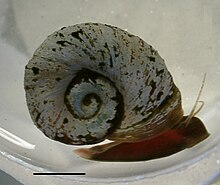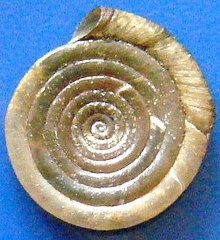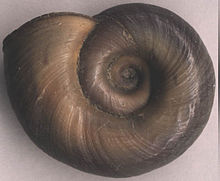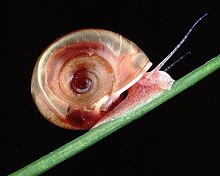扁蜷科
此条目目前正依照其他维基百科上的内容进行翻译。 (2017年4月18日) |
| 扁蜷科 | |
|---|---|

| |
| Indoplanorbis exustus | |
| 科学分类 | |
| 界: | 动物界 Animalia |
| 门: | 软体动物门 Mollusca |
| 纲: | 腹足纲 Gastropoda |
| 总科: | 扁蜷总科 Planorboidea |
| 科: | 扁蜷科 Planorbidae Rafinesque, 1815[1] |
| 属 | |
|
见内文 | |
| 多样性[2] | |
| 约250种淡水物种 | |
扁蜷科(学名:Planorbidae),亦作扁卷螺科,是腹足纲之下的一个单系群支序,本科物种皆为可呼吸空气的淡水螺[3]。原属有肺目基眼亚目椎实螺总科,今属异鳃类泛有肺类喜湿螺类支序[4]。
本科多个物种的外壳都是平旋壳(planispiral)[5],与一般腹足纲物种的外壳形状不同。外壳看似是右旋,但其实是螺把壳上下颠倒来背在身上,使左旋的外壳看起来像是右旋。 因其外形,本科物种又称羊角螺。
由于本科物种的头和腹足都比较细小,使得它们头上丝般幼的触角显得很细长。
分类
[编辑]对于部份分类元来说,是否应该归入扁蜷科仍有争议。这对于淡水帽贝Ferrissia跟Ancylus这两个属来说由其合适。这些属有时会被归入椎实螺科(Lymnaeidae Rafinesque, 1815);另外亦有文献把上述两个属放进各自的一个科里。然而,在布歇特和洛克罗伊的腹足类分类 (2005年)[3]的分类,这些属被归为扁蜷亚科(Planorbinae)之下的Ancylini族。以下将详述这个分类的具体内容。
2005年分类
[编辑]根据布歇特和洛克罗伊的腹足类分类 (2005年),本科包括下列各个亚科[3]:
- 扁蜷亚科 Planorbinae Rafinesque, 1815
- 扁蜷族 Planorbini Rafinesque, 1815[6]:synonyms: Choanomphalinae P. Fisher & Crosse, 1880; Orygoceratidae Brusina, 1882
- tribe Ancylini Rafinesque, 1815 - synonym: Pseudancylinae Walker, 1923 (inv.)
- tribe Biomphalariini H. Watson, 1954 - synonyms: Acrorbini Starobogatov, 1958; Drepanothrematini Zilch, 1959; Taphiinae Harry & Hubendick, 1964
- tribe Planorbulini Pilsbry, 1934
- tribe Segmentinini F.C. Baker, 1945
- subfamily Bulininae P. Fischer & Crosse, 1880
- tribe Bulinini P. Fischer & Crosse, 1880 - synonyms: Laevapicinae Hannibal, 1912; Isidorinae Annandale, 1922; Gundlachiinae Starobogatov, 1967
- tribe Coretini Gray, 1847 - synonyms: Pompholicinae Dall, 1866 (inv.); Camptoceratinae Dall, 1870; Megasystrophinae Tryon, 1871 (inv.); Pompholycodeinae Lindholm, 1927; Helisomatinae F. C. Baker, 1928; Bayardellini Starobogatov & Prozorova, 1990; Planorbariini Starobogatov, 1990
- tribe Miratestini P. & F. Sarasin, 1897 - synonyms: Ferrissiinae Walker, 1917; Ancylastrinae Walker, 1923; Protancylinae Walker, 1923; Physastrinae Starobogatov, 1958; Ameriannini Zilch, 1959; Patelloplanorbidae Franc, 1968
- tribe Plesiophysini Bequaert & Clench, 1939
- subfamily Neoplanorbinae Hannibal, 1912 - synonym: Payettiinae Dall, 1924
- subfamily Rhodacmeinae Walker, 1917
2007年本科部分物种的分类
[编辑]Albrecht等(2007)[6]分析过本科部分物种,based on sequences of mitochondrial 18S ribosomal DNA and cytochrome-c oxidase I (COI) genes, and on the basis of the results, they rearranged the taxonomy like this:
"A-clade" sensu Albrecht et al. (2007)[6]
- Burnupia Walker, 1912
Tribus Bulinini
- Bulinus O. F. Müller, 1781
- Indoplanorbis Annandale, 1921
Tribus Ancylini Rafinesque-Schmaltz, 1815
- Ancylus O. F. Müller, 1774
- Ferrissia Walker, 1903
- Gundlachia Pfeiffer, 1849
- Laevapex Walker, 1903
- Hebetancylus Pilsbry, 1914
"B-clade" sensu Albrecht et al. (2007)[6]
- Glyptophysa Crosse, 1872
- Protancylus Sarasin, 1897
- Kessneria Walker & Ponder 2001
- Leichhardtia Walker, 1988
Tribus Camptoceratini
- Planorbarius Duméril 1806
- 多旋螺属 Anisus Studer, 1820
- Bathyomphalus Charpentier, 1837
- 旋螺属 Gyraulus Charpentier, 1837
- Choanomphalus Gerstfeldt, 1859
- 扁蜷属 Planorbis O. F. Müller, 1774
Tribus Segmentinini
"C-Clade" sensu Albrecht et al. (2007)[6]
- Biomphalaria Preston, 1910
- Menetus H. & A. Adams, 1855
- Planorbella Haldeman, 1843
- Planorbula Haldeman, 1843
Cladogram
[编辑]The following is a cladogram that shows the phylogenic relationships within the Planorbidae according to Albrecht 2007:[6]
| ||||||||||||||||||||||||||||||||||||||||||||||||||||||||||||||||||||||||||||||||||||||||||||||||||||||||||||||||||||||||||||||||||||||||
属
[编辑]本科的模式属是 Planorbis Müller。以下列出主要根据布歇特及其他人(2005)的分类[3],因为Albrecht (2007)的分类并未整全的包括本科所有的属。至于每个属的亚属则依照 Glöer (2002) 的文献[7]。以下综合三份文献的结果:

- 扁蜷亚科 Planorbinae Rafinesque, 1815
- ?
- tribe Ancylini Rafinesque, 1815
- tribe Biomphalariini H. Watson, 1954
- Biomphalaria Preston, 1910 - type genus of tribe Biomphalariini[3]
- Drepanotrema Crosse & P. Fischer, 1880[3]
- 扁卷螺族 Planorbini Rafinesque, 1815
- tribe Planorbulini Pilsbry, 1934
- Planorbula Haldeman, 1840 - type genus of tribe Planorbulini[3]
- tribe Segmentinini F.C. Baker, 1945
- Segmentina Fleming, 1818 - type genus of tribe Segmentinini[3]
- 淤泥螺亚科 Bulininae P. Fischer & Crosse, 1880
- 印度扁卷螺属 Indoplanorbis Annandale & Prashad, 1920:单型属,只有Indoplanorbis exustus一个物种[8]。
- Planorbarius Duméril, 1806
- Planorbella Haldeman, 1842
- Menetus H. Adams & A. Adams, 1855
- subgenus Dilatata Clessin, 1885
- tribe Bulinini P. Fischer & Crosse, 1880
- Bulinus O. F. Müller, 1781 - type genus of subfamily Bulininae[3]
- Gundlachia Pfeiffer, 1849
- tribe Coretini Gray, 1847
- tribe Miratestini P. & F. Sarasin, 1897
- tribe Plesiophysini Bequaert & Clench, 1939
- Plesiophysa P. Fischer, 1883 - type genus of tribe Plesiophysini[3]
- subfamily Neoplanorbinae Hannibal, 1912
- Neoplanorbis Pilsbry, 1906 - type genus of subfamily Neoplanorbinae[3]
- subfamily Rhodacmeinae Walker, 1917
- 亚科地位未定(other genera that are not yet sorted are listed here)
- Acrorbis Odhner, 1937
- Africanogyrus Özdikmen & Darilmaz, 2007
- synonym: Afrogyrus Brown & Mandahl-Barth, 1973 - Afroplanorbis Thiele, 1931
- Amphigyra Pilsbry, 1906
- Anisopsis Sandberger, 1875
- Antillorbis Harry & Hubendick, 1964
- Armigerus Clessin, 1884
- Australorbis Pilsbry, 1934
- Bayardella Burch, 1977
- Berellaia Laubrière & Carez, 1880
- Camptoceras Benson, 1843
- Camptoceratops Wenz, 1923
- Carinifex W.G. Binney, 1865
- Carinogyraulis Polinski, 1929
- Ceratophallus Brown & Mandahl-Barth, 1973
- Choanomphalus Gerstfeldt, 1859
- Culmenella Clench, 1927[9]
- Fossulorbis Pilsbry, 1934
- Glyptophysa Crosse, 1872
- Helicorbis Benson, 1855
- Helisoma Swainson, 1840
- Intha Annandale, 1922
- Isidorella Tate, 1896
- Kessneria Walker & Ponder, 2001
- Leichhardtia Walker, 1988
- Lentorbis Mandahl-Barth, 1954
- Macrophysa (Meek) Dall, 1870
- Paraplanorbis Hanna, 1922
- Patelloplanorbis Hubendick, 1957
- Pecosorbis D.W. Taylor, 1985
- Pentagoniostoma Branson, 1935
- Perrinilla Hannibal, 1912
- Physastra Tapparone-Canefri, 1883
- Physopsis Krauss, 1848
- Pingiella F.C. Baker, 1945
- Pitharella F. Edwards, 1860
- Planorbifex Pilsbry, 1935
- Planorbina Haldeman, 1842
- Platyphysa P. Fischer, 1883
- Platytaphius Pilsbry, 1924
- 多脉扁螺属 Polypylis Pilsbry, 1906
- Promenetus F.C. Baker, 1935
- Protancylus P. & F. Sarasin, 1897
- Pygmanisus Iredale, 1943
- Segmentorbis Mandahl-Barth, 1954
- Sineancylus Gutiérrez Gregoric, 2014
- Syrioplanorbis F.C. Baker, 1945
- Trochorbis Benson, 1855
- Vorticifex Meek in Dall, 1870
The genus Camptoceratops Wenz, 1923 is no longer considered to be a planorbid. It was recognised by Curry (1965, p. 360) as a euthecosomatous pteropod (Heterobranchia) (note by Arie W. Janssen, 092507).
属名 Taphius H. Adams & A. Adams, 1855 为Biomphalaria的异名。[3]
Shell description
[编辑]
The shells of most species in this family are disk-like or button-like, being coiled in one plane, although several groups have shells that are more higher-spired, and some are limpet-like.
All coiled shell Planorbidae are sinistral in their shell coiling, as is proved by their internal anatomy (the respiratory and the genital orifice are situated on the left side), however the animals carry their shells with what would normally be the ventral (i.e. umbilical) surface uppermost, and because of this, the shells appear to be dextral.
Indeed, formerly planorbids were thought to have dextral shells, and so species of this family were figured as if they had dextral shells. Although it is now understood that these species are sinistral in shell coiling, disk-like Planorbid shells are often still shown in illustrations oriented as if they were dextral.
Most species of coiled planorbids have a rather thin and moderately smooth shell, although more distinct sculpture such as a keel occurs in, and is diagnostic of, certain species. In the flat, keeled species, the whorls tend to overlap.
The aperture has a sharp outer lip. A peristome can be present, but often the lip is not thickened nor reflected. Those planorbid species which have a high-spired shell may have a narrow umbilicus, but frequently this is covered by callus.
In height most species vary between 6 mm and 6 cm, however, disk-like shells are usually less than about 2 cm in maximum dimension.
Like all pulmonate aquatic snails, ramshorn shells do not have an operculum to close the shell aperture.
Sinistral shells
[编辑]


Flat-coiled planorbid gastropod shells are hard to understand in terms of their coiling and orientation. Many of the shells of species in this family are almost planispiral in coiling such that one side of the shell often looks rather like the other side, but it is important to bear in mind that nonetheless there is an umbilical side and a spire side of the shell. In addition these are in fact sinistral shells, despite the fact that the snail carries its shell as if it were a normal dextral shell. To make sense of the shell coiling, the following facts are useful:
- In life, these pond snails hold their shells upside down compared to the normal gastropod shell orientation, with the umbilicus facing upwards
- The spire of the shell is quite sunken in many species, in addition it is carried facing downwards
- The umbilicus of the shell is very wide and shallow
- In some species the umbilicus is not as deeply "dished" as the sunken spire is, so superficially it can be hard to tell one from the other
However, once it is understood that the planorbid shell is sinistral, if the shell is held with the aperture on the left and facing the observer, then the sunken spire side of the shell is uppermost. This is a convenience for understanding the shell, but is the opposite of the way the shell is actually carried in life.
The side of the shell which is in fact the spire (a sunken spire) faces down in the living animal, contrary to what is the case in almost all other shelled gastropods. Because the shell is carried "upside down" like this, the aperture of the shell is angled to face downwards also, so the aperture faces a little towards the spire, not away from it, as is usually the case in other shelled gastropods.
血色素
[编辑]相对于其他的软体动物,扁卷螺科物种的血液都含有血红素。因此,这些动物呼吸氧气时都较其他软体动物来得更有效;而血红素亦令这些动物的身体带红色,这尤其在白化物种身上更明显。
习性
[编辑]扁卷螺科的大多数物种都只能在淡水生活,只有少数物种能存活于咸淡水交界。所以对于其他未能存活于咸淡水的物种,亦令农夫可以用食盐来清除它们。
Geological history
[编辑]Ancestors of ramshorn snails are known with certainty since the Jurassic period. Modern taxa developed since the Cretaceous.
Geographical distribution
[编辑]Species in this family occur worldwide. In Northwest Europe about 20 species are known (including non-indigenous species). In this region, various extinct taxa are known to have occurred, starting in the Jurassic period.
参看
[编辑]参考文献
[编辑]- ^ Rafinesque, C. S. Analyse de la Nature ou tableau de l'univers et des corps organisés. Palermo. 1815: 223 pp., page 143 (法语).
- ^ Strong, E. E.; Gargominy, O.; Ponder, W. F.; Bouchet, P. Global Diversity of Gastropods (Gastropoda; Mollusca) in Freshwater. Hydrobiologia. 2008, 595: 149-166. . doi:10.1007/s10750-007-9012-6 (英语).
- ^ 3.00 3.01 3.02 3.03 3.04 3.05 3.06 3.07 3.08 3.09 3.10 3.11 3.12 3.13 3.14 3.15 3.16 Bouchet, P.; Rocroi, J.-P.; Frýda, J.; Hausdorf, B.; Ponder, W.; Valdés, Á. & Warén, A. Classification and nomenclator of gastropod families. Malacologia (Hackenheim, Germany: ConchBooks). 2005, 47 (1–2): 1–397. ISBN 3-925919-72-4. OCLC 61351079. OL 42989175M. S2CID 83847814.
- ^ 《香港淡水貝類 - 腹足綱》. 香港自然生态论坛. 2015-02-15 [2015-04-30]. (原始内容存档于2015-07-04) (中文(繁体)).
- ^ planospiral什么意思及同义词. 沪江词库. [2016-09-30]. (原始内容存档于2016-10-02).
- ^ 6.0 6.1 6.2 6.3 6.4 6.5 Albrecht, C.; Kuhn, K.; Streit, B. A molecular phylogeny of Planorboidea (Gastropoda, Pulmonata): insights from enhanced taxon sampling. Zoologica Scripta. 2007, 36: 27–39. doi:10.1111/j.1463-6409.2006.00258.x (英语).
- ^ Glöer, P. Die Süßwassergastropoden Nord- und Mitteleuropas (北歐和中歐的淡水腹足類動物). Die Tierwelt Deutschlands [德国的动物] ?. Hackenheim, Germany: ConchBooks. 2002: 19–20. ISBN 3-925919-60-0 (德语).
- ^ Liu L et al. (2010) "The phylogeography of Indoplanorbis exustus (Gastropoda: Planorbidae) in Asia". Parasites & Vectors 3: 57. doi:10.1186/1756-3305-3-57.
- ^ Mollusc Specialist Group (1996). Culmenella rezvoji. In: IUCN 2010. IUCN Red List of Threatened Species. Version 2010.4. <www.iucnredlist.org>. Downloaded on 08 March 2011.
外部链接
[编辑]- (英文) NCBI Taxonomy Browser: Planorbidae (页面存档备份,存于互联网档案馆)
- (英文) Systema naturae 2000 (classification) - Taxon: Planorbidae (页面存档备份,存于互联网档案馆)
- Planorbidae. ITIS.
- (英文) http://mkohl1.net/Planorbidae.html (页面存档备份,存于互联网档案馆)
- Frank Collins Baker, The Molluscan Family Planorbidae, The University of Illinois press, Urbana, 1945
